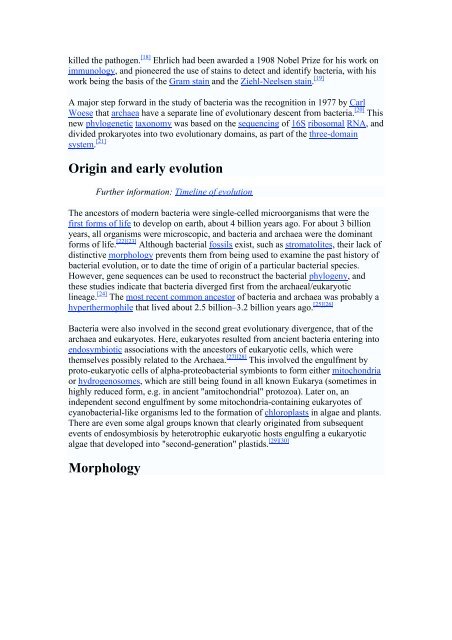Amoeboid - Thierry Karsenti
Amoeboid - Thierry Karsenti
Amoeboid - Thierry Karsenti
You also want an ePaper? Increase the reach of your titles
YUMPU automatically turns print PDFs into web optimized ePapers that Google loves.
killed the pathogen. [18] Ehrlich had been awarded a 1908 Nobel Prize for his work on<br />
immunology, and pioneered the use of stains to detect and identify bacteria, with his<br />
work being the basis of the Gram stain and the Ziehl-Neelsen stain. [19]<br />
A major step forward in the study of bacteria was the recognition in 1977 by Carl<br />
Woese that archaea have a separate line of evolutionary descent from bacteria. [20] This<br />
new phylogenetic taxonomy was based on the sequencing of 16S ribosomal RNA, and<br />
divided prokaryotes into two evolutionary domains, as part of the three-domain<br />
system. [21]<br />
Origin and early evolution<br />
Further information: Timeline of evolution<br />
The ancestors of modern bacteria were single-celled microorganisms that were the<br />
first forms of life to develop on earth, about 4 billion years ago. For about 3 billion<br />
years, all organisms were microscopic, and bacteria and archaea were the dominant<br />
forms of life. [22][23] Although bacterial fossils exist, such as stromatolites, their lack of<br />
distinctive morphology prevents them from being used to examine the past history of<br />
bacterial evolution, or to date the time of origin of a particular bacterial species.<br />
However, gene sequences can be used to reconstruct the bacterial phylogeny, and<br />
these studies indicate that bacteria diverged first from the archaeal/eukaryotic<br />
lineage. [24] The most recent common ancestor of bacteria and archaea was probably a<br />
hyperthermophile that lived about 2.5 billion–3.2 billion years ago. [25][26]<br />
Bacteria were also involved in the second great evolutionary divergence, that of the<br />
archaea and eukaryotes. Here, eukaryotes resulted from ancient bacteria entering into<br />
endosymbiotic associations with the ancestors of eukaryotic cells, which were<br />
themselves possibly related to the Archaea. [27][28] This involved the engulfment by<br />
proto-eukaryotic cells of alpha-proteobacterial symbionts to form either mitochondria<br />
or hydrogenosomes, which are still being found in all known Eukarya (sometimes in<br />
highly reduced form, e.g. in ancient "amitochondrial" protozoa). Later on, an<br />
independent second engulfment by some mitochondria-containing eukaryotes of<br />
cyanobacterial-like organisms led to the formation of chloroplasts in algae and plants.<br />
There are even some algal groups known that clearly originated from subsequent<br />
events of endosymbiosis by heterotrophic eukaryotic hosts engulfing a eukaryotic<br />
algae that developed into "second-generation" plastids. [29][30]<br />
Morphology


